By 2 June 1940, Operation Dynamo, the evacuation of the British Expeditionary Force (BEF) from the Dunkirk Salient, was approaching the point of completion. The bulk of British soldiers waiting on the beaches, or at the Mole, had been lifted and less than 10,000 troops of the BEF now remained[ref]WO 106/1613, Evacuation of Dunkirk Area: Total number of troops (British, Allies, Fit, Wounded) evacuated from 20 May to 4 June, 1940.[/ref]. Just one last task had to be undertaken: the evacuation of a rearguard of almost 60,000 soldiers of the French 1st Army, who had fought to protect much of the perimeter around Dunkirk.
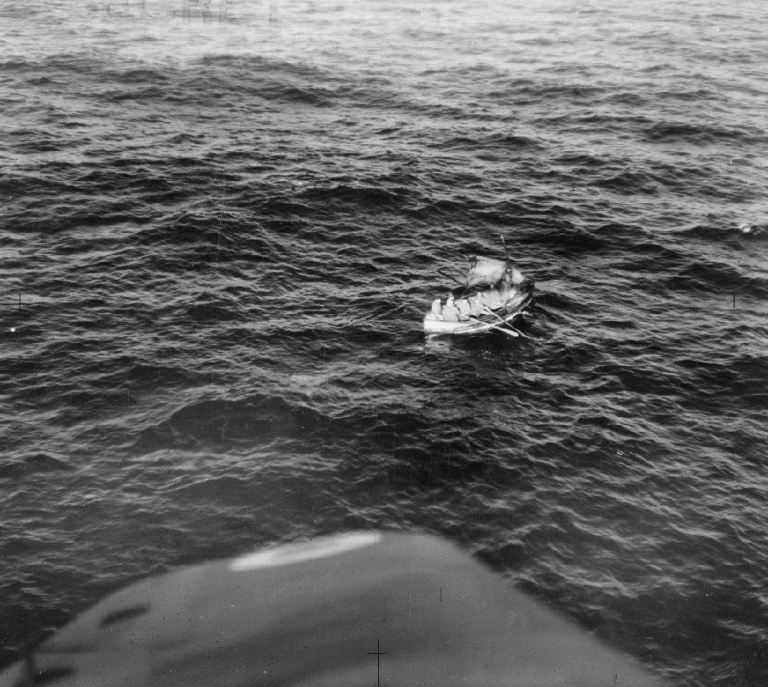
For all this, the Royal Navy had born the burden of responsibility, and it was truly the fast ships of Britain’s Home Fleet that had delivered the ‘miracle of Dunkirk’. From the formal commencement of Dynamo on 26 May, a force of destroyers and minesweepers had operated a near-continuous ferry service from Dover and other naval ports on the south coast of England.
The effort rendered by the ‘senior service’ was gargantuan. The vessels placed at the disposal of Vice-Admiral Bertram Ramsay included 39 destroyers, which was one fifth of the Royal Navy’s total, 38 minesweepers and 61 minesweeping craft, eighteen 18 anti-submarine trawlers, six corvettes, one sloop and 79 other small craft, including motor torpedo boats, gunboats and flare-burning drifters. Lastly, this force was supported by at least one capital ship, the anti-aircraft cruiser Calcutta[ref]Julian Thompson, Dunkirk: Retreat to Victory (London: Pan Macmillan, 2009), p. 224.[/ref].
However, at a midpoint in the evacuation, the courage, morale and energy of the Royal Navy crews involved in the evacuation seemed as though it had hit rock bottom. It was Friday 31 May, and Ramsay’s naval task force had been engaged in the evacuation for five continuous days without rest or respite. Thus, the Flag Officer at Ramsay’s headquarters in Dover Castle sent out the following message to all ships and shore authorities (WO 106/1613):

There is little doubt that Ramsay’s force endured the most horrific ordeal in conveying troops from Dunkirk across the Channel, and the bravery of the Royal Navy crews involved in the operation was nothing short of exemplary. The exploits of HMS Jaguar on 30 May were among the most breathtaking. The ship survived 21 separate air attacks by Luftwaffe aircraft; six dive-bombing attacks occurred as Jaguar approached Dunkirk harbour, one high-level bombing attack took place while the ship embarked a thousand troops at the jetty, and a further 12 dive-bombing attacks as she left the harbour.
One bomb exploded quite close to the port side, killing 12 and wounding 30, while also shattering the fuel and steam pipes and leaving a hole in the hull near the waterline. Jaguar transferred her load of troops to HMS Express and after an hour at anchor, she raised steam and proceeded towards Dover at a speed of 20 knots. The ship would be attacked twice by high-level bombers as she left, but Jaguar eventually reached Dover safely (WO 106/1613).

However, of all the ships that took part in Dynamo, HMS Sabre was by far the most conspicuous in the evacuation of both British and French soldiers from the beaches and harbour of Dunkirk. Sabre made ten round trips over the course of nine days and nights, more than any other ship involved in the operation, and did so in spite of damage she sustained during an air attack. Walter Lord, in his book, ‘The Miracle of Dunkirk’, provides a short summary of Sabre’s extraordinary accomplishments during Dynamo:
‘In the early hours of 28 May, three ships boats from HMS Sabre picked up 100 men in two hours, from the beaches at Malo-Les-Bains to the east of the harbour mole. Then it was full speed to Dover with a turnaround of only 58 minutes, and the ship was back again at the Dunkirk harbour mole at 11:00am, where they loaded a further 800 men. Departing at 12:30pm, by now the ship’s weight had increased considerably, lowering her propeller draft. This meant because of the falling tide and a defective echo sounder, Lieutenant-Commander Dean had to slowly edge her passage through the shallows. She arrived back in Dover at 6:20pm. Refuelled, she was back to the Dunkirk mole at 10.30pm, the third trip of the day. This time, the ship stayed for only 35 minutes picking up another 500 troops.’[ref]Walter Lord, The Miracle of Dunkirk (London: Wordsworth Military Library, 1998), p. 116.[/ref]
Sabre brought a total of 5,765 British and French soldiers home to Dover, the highest number recorded for any individual ship. Her commanding officer, Lieutenant-Commander Dean, was awarded the Distinguished Service Order for his actions on 6 June, and nine of the ship’s crew were mentioned in despatches.[ref]Ibid.[/ref]
The number of other brave vessels and crews which were involved in the operation are too numerous to name. A total of 861 Allied ships were involved in the evacuation, of which 243 were sunk, and this figure includes nearly 700 British ships, of which 226 were sunk[ref]Winston Churchill, Their Finest Hour: The Second World War. Vol. II (Boston; Toronto: Houghton Mifflin, 1949), p. 102.[/ref]. Of these, the smallest number of sinkings had been Royal Navy warships; only six destroyers and five minesweepers were lost. However, these losses had been hard felt by the navy, particularly on 1 June, the second-worst day of the evacuation, when the destroyer HMS Keith had been lost, along with three minesweepers, a number of Merchant Navy ships and smaller vessels[ref]Hugh Sebag-Montefiore, Dunkirk: Fight to the Last Man (Cambridge MA: Harvard University Press, 2006), p. 416.[/ref].
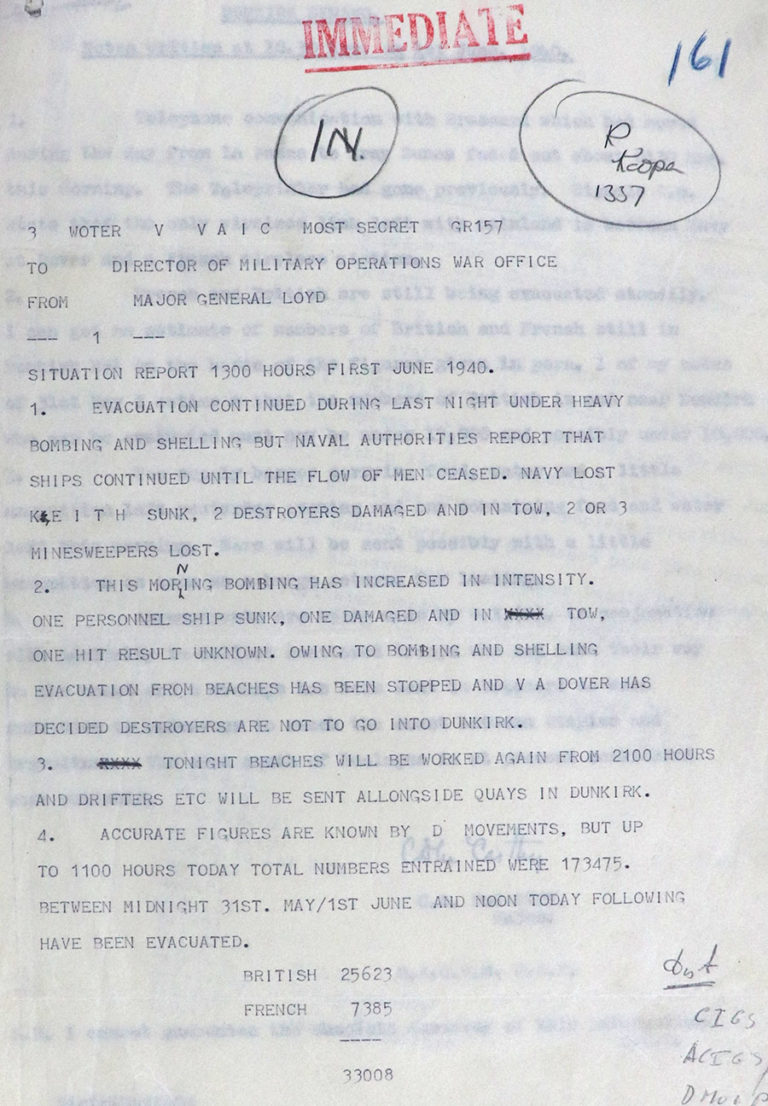
There is little doubt that the courage and resilience of the Royal Navy was a key factor in the success of Dynamo, and fundamental to the saving of the BEF. However, what was even more remarkable about the naval operation was the manner in which it came to a conclusion. A reduced force of destroyers would continue to evacuate a contingent of French troops which had performed a rearguard action to protect the BEF. Over the course of 2-4 June, exhausted destroyer crews rescued 60,000 French soldiers, thereby honouring Britain’s pledge to its ally, while denying Hitler a crucial victory during his conquest of France[ref]WO 106/1613, Message from Admiralty to Vice-Admiral Dover, 2 June 1940.[/ref].
ADM 199/786
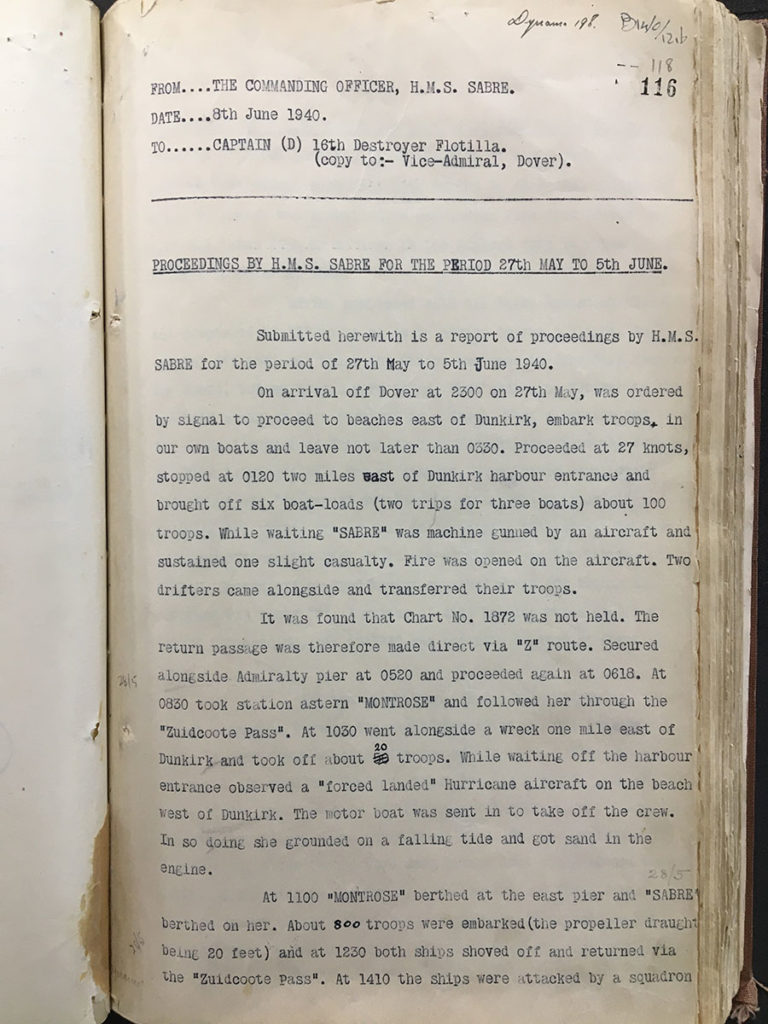
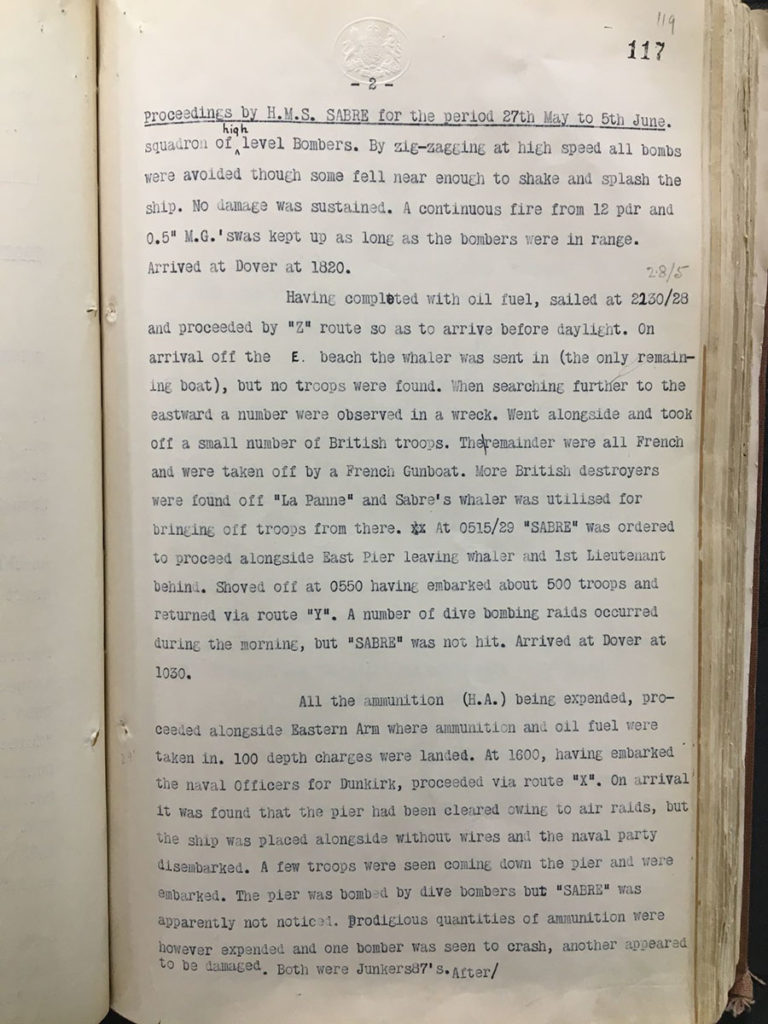
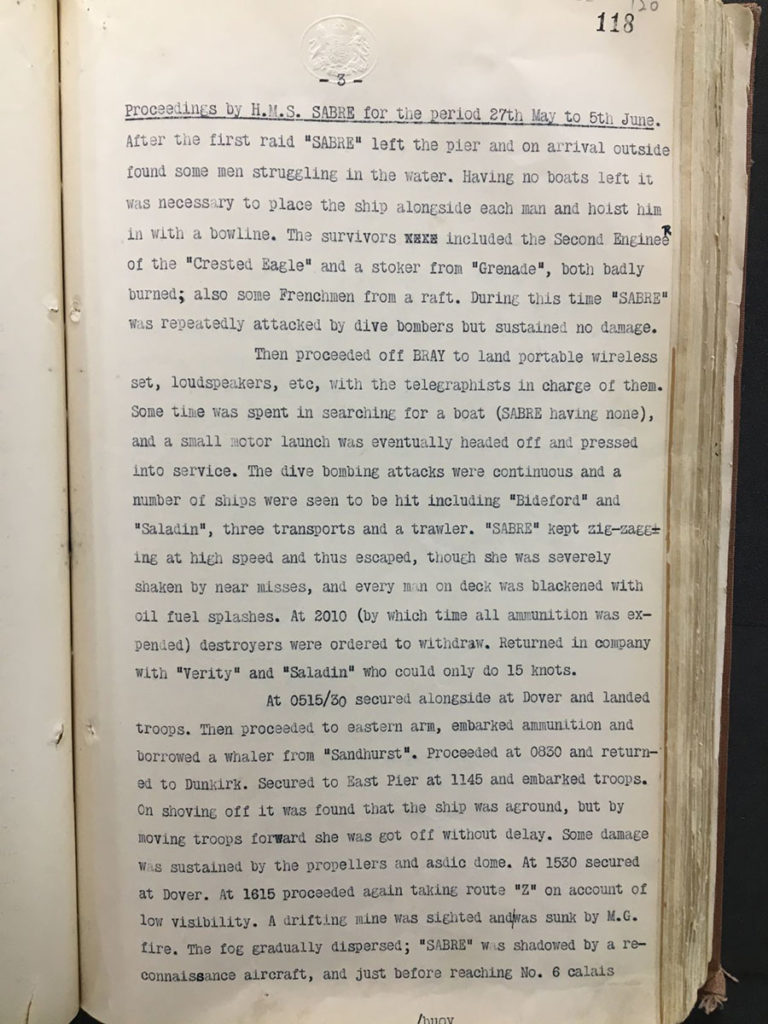
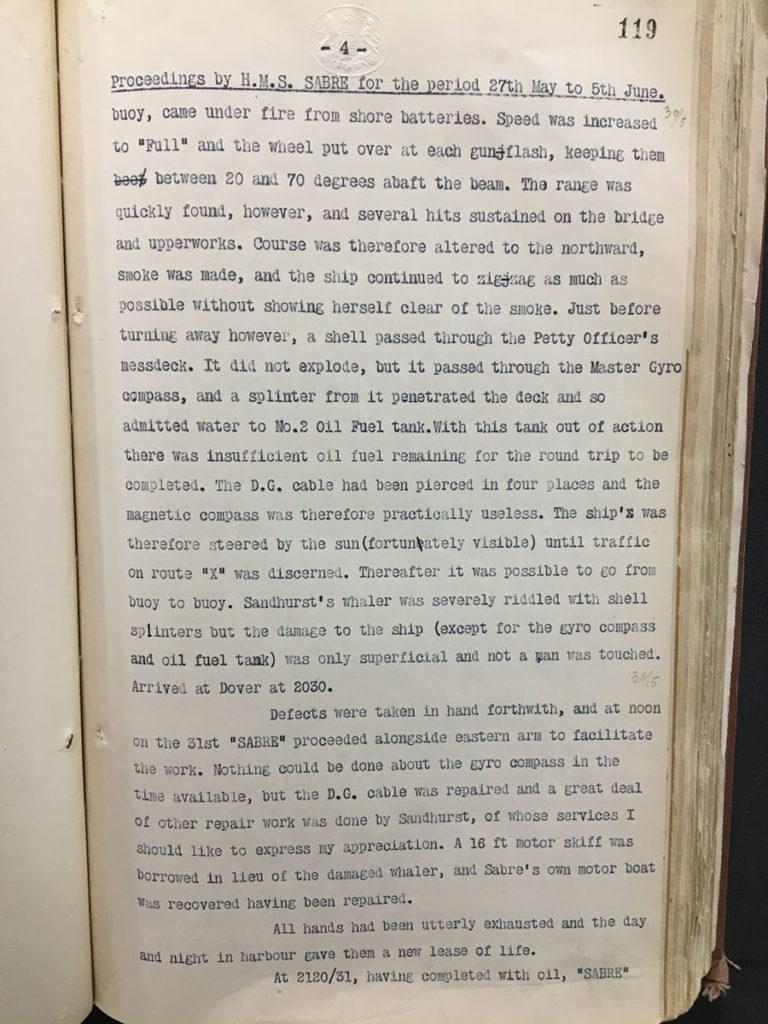
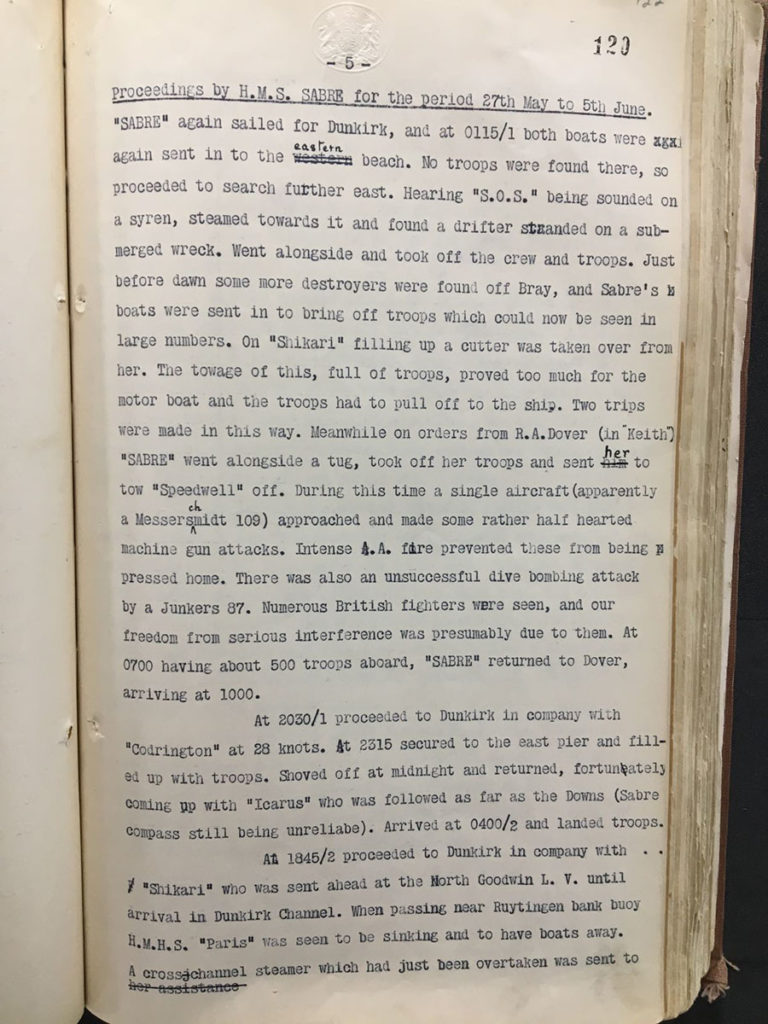

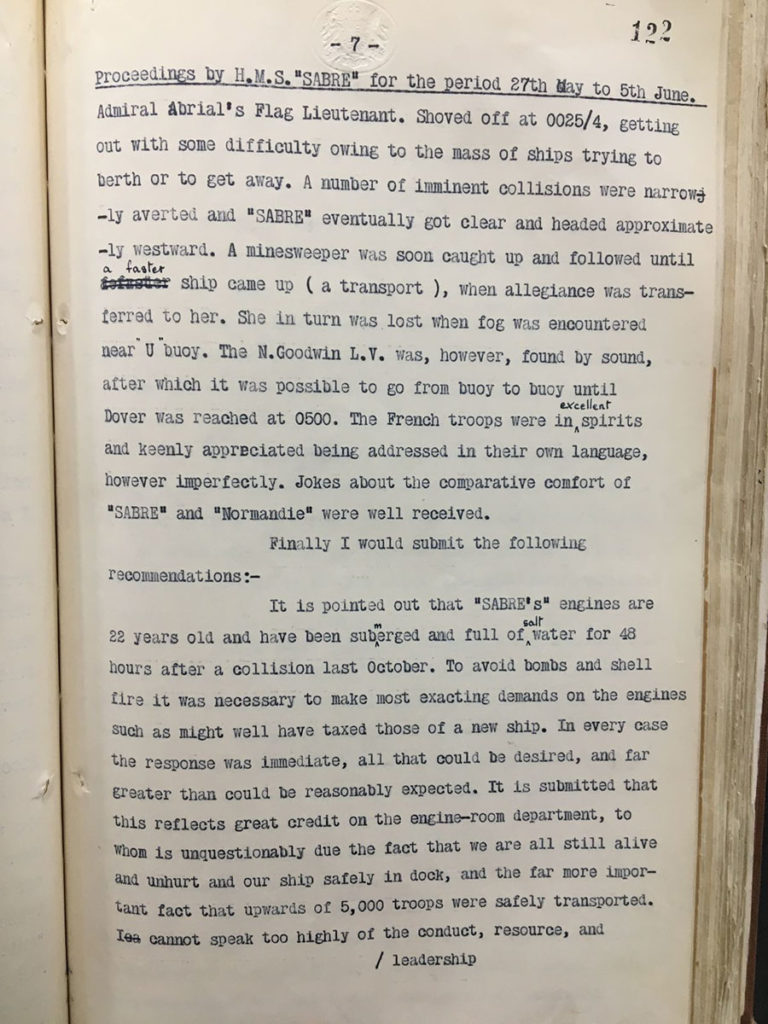
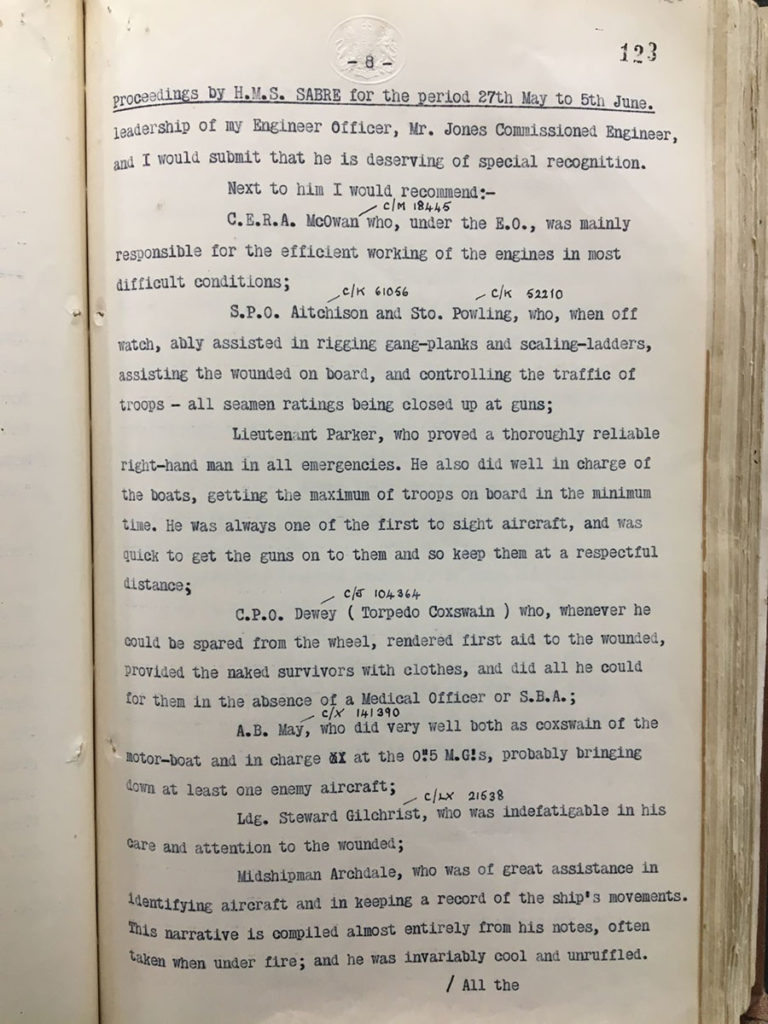
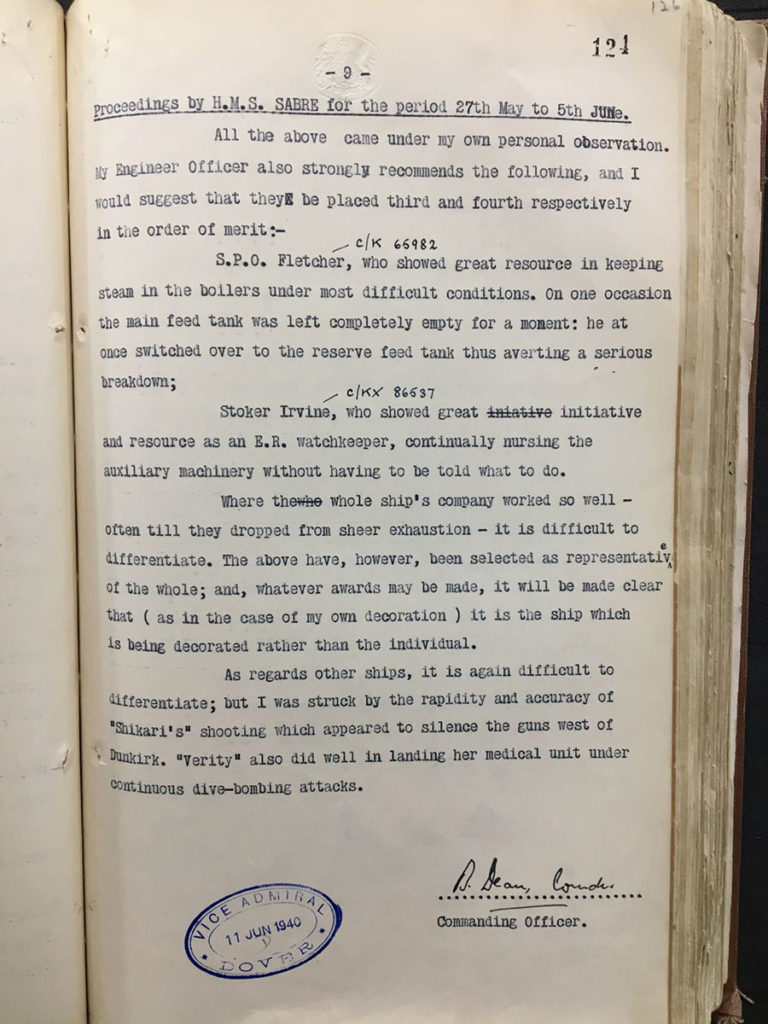
See also: The Dunkirk Evacuation – Part 1: Where was the RAF?
In accounts of this and many other operations the sheer numbers – as well as the individual accounts – grab the attention.
Ten thousand BEF troops remaining, 600,000 French troops and 20% of the Royal Navy help to show not only the importance of the operation but the way in which forces were constituted before technology – much of it rooted in advances made during the Second World War – increased military capability.
In addition the attacks endured by HMS Jaguar are yet another indication of the overwhelming power of the German forces at this time, the build-up of which Britain and France had chosen to ignore for a variety of reasons.
Please do not forget Operations Cycle and Ariel, which between them rescued over 150,000 members of the BEF who were still in France, after Operation Dynamo had finished.
Also it is the eightieth anniversary of the sinking on the 17th June 1940 of HMT Lancastria in the Charpentier roads, off Saint Nazaire, which resulted in the loss of up to 7,000 soldiers, sailors, civilians and airmen. The exact toll is unknown. HMT Lancastria was taking part in Operation Ariel
This is so interesting, thank you so much.
I hope you will continue with Operation Ariel, the later evacuation from the Western ports. My father, Private John Edward Blunden, aged 26 was mobilised with the Territorials to join the BEF in early 1940 and evacuated from St Nazaire probably on 17th June, 1940. He saw the bombing and sinking of the Lancastria, having been turned away from boarding it. He was taken off the following day from the Mole, in one of the small merchant ships which went directly to Plymouth, passing the wreckage of Lancastria and the still burning sea in which many bodies still floated. Operation Ariel is rarely mentioned in the accounts of the evacuation of the BEF and I would like the public more widely to have an opportunity of learning about it.
Hi David and Gillian,
Thank you so much for your kind comments and suggestions.
I would certainly be delighted to do something on the sinking of the Lancastria and the evacuation of the second BEF. However, we are extremely restricted in terms of of archival material that we can access owing to the Covid 19 lockdown.
This blog was written with the aid of material that I had photographed, mercifully, just before lockdown was implemented.
Our institution still has procedures in place, as you can probably appreciate. However, I will do my very best to cover this topic, if I can get my hands the research materials.
Thanks again for this excellent suggestion!
Joseph
My test for any account of Dunkirk has always been “What does it say about the roles of Admirals Somerville and Wake-Walker and Captain Tennant?” The roles of Ramsay and the captains of the small craft are well known, but these 3 played a remarkably important role. Can you publish something about each of them.
Yes a great debt is owed to the Royal Navy. I was pleased to see HMS Calcutta mentioned above as my grandfather, Harold Reginald Gates, served aboard her and actually went ashore at Dunkirk in a cutter to uplift troops. I have recently written a book which gives full details of Calcutta’s involvement in Operation Dynamo, from both the Captain’s report, D. M. Lees, and the ships logs at the The National Archive. It includes every ship, and small boat, that went alongside her during the evacuation. Calcutta was heavily involved in the operation and sustained constant attacks. Also mentioned above is Operation Ariel, and Calcutta too went from Dunkirk and into this action. In the confusion of the 25th June, during the evacuation, HMS Calcutta rammed HMCS Fraser, cutting the ship in half and sinking her with loss of life.
Brian – could you please let me know the name of your book and how to obtain a copy.
My father was picked up from the sea at Dunkirk by a French fishing boat which transferred him to HMS Calcutta.
My father was part of the rear guard and when released from their stations, he and a friend ran to the beach and managed to find half a life boat in the surf. If they both sat in the stern and paddled they made slow progress out into the bay. The Germans were now in the sand dunes and taking pot shots at them. A RN ship picked them up whilst doing a last sweep. They returned to Dover some days after the main BEF had been saved. Do you know which Ship did this last sweep? My father was a Sgt in the Middlesex Reg.
Thanks
I understand my grandfather rear admiral Hubert Dannreuther one of the six survivors of the Invincible sunk at Jutland had a motor boat he kept on the Thames and used to pick up soldiers from Dunkirk.Is this true and where can I find out more about this?
I also understand he was in charge of or had some responsibility for the Atlantic or Arctic convoys despite being retired from the Navy in 1933.Is this true and where can I find out more about this?
Dear David,
Thank you for your comment.
To ask questions relating to family history, please use our live chat or online form.
We hope you might also find our research guides helpful.
Brian Gates, I’ve searched for your book but been unable to locate it. I would love to read it as my Great Grandfather was rescued by the Calcutta at Dunkirk.